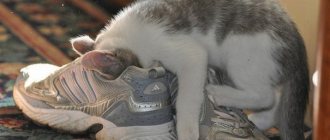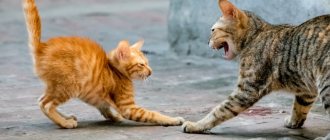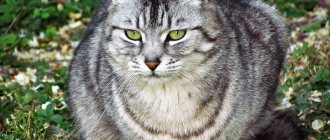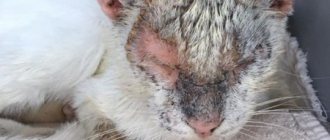Home » Useful Information
Cat owners often find that their pet begins to lose hair much more intensely than during normal shedding. The cat develops bald patches and the owners panic. There can be many causes of alopecia in animals.
- 2 What you can do yourself
- 3 When to contact a specialist
Alopecia, or feline hair loss: what is it?
All cats shed twice a year, and this is the norm. How to distinguish: is it molting (the process when the fur is renewed) or pathology (baldness of the animal)? To do this, you need to know how the disease manifests itself, what its prerequisites are and in what cases the owner needs to sound the alarm.
Alopecia is the name given to abnormal hair loss in cats, as a result of which bald spots are formed on the animal's body - areas with absolutely no hair. The fur may fall out in clumps, forming bald areas on the animal's head, ears, and paws. Having noticed such areas, the owner should immediately take the pet to an appointment with a veterinarian. Baldness can be a signal of serious problems in the animal’s body.
But this should not be confused with hair loss, which normally occurs in all healthy felines. Cats lose their fur during:
- molting (a seasonal change of “coat” occurs twice a year; cats usually shed more than males);
- stress (the animal may shed some hair due to excitement);
- age-related changes (old animals lose hair and whiskers);
- frequent bathing (this is why it is recommended to bathe the animal only if necessary; twice a year is quite enough).
At the same time, the wool does not come out in clumps, without forming bald spots. But the disease has slightly different symptoms.
What you can do yourself
Lice mites can cause hair loss in cats.
Treatment of alopecia requires supervision by a specialist and is selected individually for each animal. First of all, owners can independently exclude allergy factors by analyzing changes in the pet’s diet recently or the appearance of new odors, plants or objects in the house, and also examine the cat for the presence of fleas or other parasites.
Alopecia symptoms
You can recognize alopecia in a pet by the following signs:
- The fur falls out excessively, in clumps. Bald spots in cats appear mainly behind the ear, in the neck, back, and on the tail.
- The skin in these places may have its usual pink color or turn red, sores or scabs may appear there.
- Check your pet's reaction to touching the bald spot: perhaps the spot hurts or itches.
- Check if the animal has symmetrical bald spots.
If you notice these symptoms, you should urgently seek professional help from a veterinarian. Otherwise the disease will progress.
How to treat the disease?
To quickly cure a cat, you need to know the source of the disease and why the cat’s hair came out. If a cat suffers from baldness due to allergies, then the owner must protect the pet from the irritant. Afterwards, the cat is prescribed histamines, immune system stimulants and hypoallergenic products. If the source is parasites, then bald spots on the tail, back, and legs are treated with ointment against ticks or fleas. In addition, the veterinarian prescribes medications that improve the functioning of the immune system. For endocrine diseases, drugs are used that restore the action of the glands. If alopecia in cats is caused by an abscess, then antiseptics and antibiotics are prescribed.
Baldness of a psychogenic nature is treated with soothing drops on a natural basis.
Causes of this disease
If an animal has bald spots on its body and head, this may be a sign of a food allergy. Allergies should be looked for in your pet's diet. They can be:
- Proteins of animal and plant origin;
- Various cereals;
- Meat – in particular lamb.
In addition, it may be an allergic reaction to flea bites, cigarette smoke or other odors (inhalation allergy).
The causes of baldness may lie in the psychological state of the pet, that is, hair may fall out due to stress. If the veterinarian diagnoses this reason, then the first thing the owner needs to do is find out what kind of stress or experience the pet has had recently, eliminate it, and only after that give sedatives, which only in this case will be effective. Symptoms of alopecia of a psychogenic nature are bald patches that are located on the thighs, abdomen or paws.
The causes belonging to the third group are infectious. If a cat's hair is falling out, the culprit may be scabies, lichen, fungus, or mites. If a cat has a bald spot behind its ear, it could be ringworm. There are several varieties: fungal (another name is ringworm; contagious to humans), psoriasis or eczema, viral.
Hair mites can also cause hair loss. They are very small and impossible to notice with the naked eye. Lice eaters do not live long, but they reproduce very quickly.
If your cat has bald spots on its neck, the cause may be dermatitis. It can be caused by various chemical and biological factors. Even treatment for parasites can cause hair loss.
Hair loss can be a consequence of seborrhea, a disease in which the functioning of the sebaceous glands is disrupted. This is usually indicated by baldness in a cat near the tail. That is why this disease is sometimes called “greasy tail”.
Another group of problems that cause baldness is disruption of the hormonal system:
- thyroid problems, manifested by both increased and insufficient levels of hormone production;
- diabetes;
- malfunctions of the adrenal glands, in particular their hyperfunction.
Other reasons include the presence of tumors in the animal, genetic predisposition and reactions to medications. Thus, a kitten’s bald spot may appear due to the fact that during pregnancy its mother did not receive various essential minerals and vitamins.
How to distinguish normality from pathology?
Baldness of skin areas is not always caused by pathological reasons. In some cases, hair loss occurs in cats that have recently given birth to kittens. The problem arises due to an unbalanced diet. A nursing mother needs increased nutrition and vitamin intake.
In animals of smooth-haired breeds, bald spots can occur as a result of regular licking of the fur, due to genetic predisposition.
Hair loss may indicate nervous strain that has arisen in the cat as a result of moving or having a new pet. Such situations are stressful for the pet; treatment is by taking sedatives.
Vitamin deficiency can be another reason for hair loss.
Diagnosis of the disease
If a cat's hair falls out in clumps before bald spots form, it should definitely be seen by a specialist. Only a veterinarian can accurately determine the diagnosis. To determine the disease and prescribe the correct treatment, the doctor must:
- Find out how and when the disease manifested itself. The owner will have to tell in great detail the animal’s lifestyle, what the pet ate and drank, what it came into contact with, and whether it walked outside.
- Examine the patient.
- Examine hair roots under a microscope.
- You may need blood and hormone test data, and a scraping will be required.
- Sometimes an ultrasound or x-ray is done to confirm or rule out the presence of tumors.
Why does a cat's tail go bald at the base?
Owners of “mustachioed tabby cats” often encounter cat diseases that can have various manifestations, including tail baldness.
In fact, this is not a separate disease, but a symptom that may indicate various health problems. Not all of them are a serious threat to the pet’s life, but they can cause quite a lot of problems and discomfort.
The cat's tail is going bald- The cat's tail is going bald
There are many reasons for a cat's tail to become bald. The most common diseases encountered in cats are:
1. Skin diseases. In this case, the cat is overcome by itching, and therefore the animal combs out and chews out the hair. Very often, foci of skin diseases are localized precisely on the tail, although lesions are also possible in other parts of the body. Skin diseases bring a lot of suffering to the animal, so it is necessary to use various drops and shampoos, which can be easily purchased at any veterinary pharmacy. However, before purchasing special products, you should consult a doctor, since skin diseases can occur for various reasons: due to the activity of parasites, allergic reactions, infections.
2. Dermatomycosis. This is a group of diseases caused by fungi that are transmitted from a sick animal to a healthy one, but people are also susceptible to infection. Symptoms of dermatomycosis are shedding of hair, the fur becomes brittle, but the cat does not suffer from itching and does not comb itself. As soon as the tail begins to become bald, you should immediately contact a veterinarian, who will prescribe special ointments and, possibly, antibiotics for oral administration.
The most commonly prescribed drug is called Griseofulvin, which is very effective but has side effects.
It is also suggested to treat the lesions with a solution of calendula or hydrastis, which will help relieve inflammation and promote faster healing. Special shampoos containing vinegar and active ingredients can also alleviate the condition. It should be remembered that dermatomycosis is very contagious, so treatment should be started as early as possible. Until all symptoms completely disappear and for some time after their disappearance, it is necessary to isolate the cat from other animals and people, and disinfect the room with chlorine solutions.
- The cat's tail is going bald
- The cat's tail is going bald
3. Oily seborrhea. Caused by excessive sebum secretion, which is the result of pathological changes in the skin. This is not a dangerous condition, however, oily seborrhea can lead to more serious consequences over time: dermatitis, and subsequently eczema. Shampoos containing salicylic acid, as well as wiping with alcohol or vodka, will help solve the problem.
4. Diseases of the gastrointestinal tract.
Chronic digestive disorders, diseases of the stomach, kidneys and liver can lead to hair loss in the tail area.
In addition, vomiting and diarrhea, a depressed state of the animal, increased body temperature, and weight loss may be observed. Diseases of the gastrointestinal tract develop for various reasons, including nutritional disorders, heredity, and immune disorders. The correct diagnosis must be made by a veterinarian, after which he will prescribe adequate treatment.
5. Endocrine alopecia. Hair loss of the tail is often observed after sterilization due to hormonal imbalance, although this cause is not clearly defined. In this case, the hair falls out on the sides and often on the tail symmetrically on each side, while the cat does not feel itching or other discomfort, and the skin has a normal appearance. If after sterilization the hair begins to fall out, you need to contact a veterinarian who will prescribe hormonal therapy.
6. Lack of vitamins during pregnancy and lactation. Quite often, a pregnant or lactating cat begins to lose hair, including on its tail. If this condition occurs, vitamins and minerals should be introduced into the diet and, if possible, kittens should be separated from the cat earlier. However, such decisions should only be made by a doctor. By the way, a similar situation can arise when the cat eats poorly or improperly. In this case, it is also necessary to review the diet and introduce multivitamin complexes into the diet.
7. Stress. Severe stress or fear can lead to baldness of the tail. In addition to this symptom, you can notice a change in appetite, the cat’s aggression, it begins to scratch furniture and make marks. Sometimes it happens the other way around: the cat does not behave aggressively, but becomes lethargic and inhibited. If you do not pay attention to all these symptoms, then stress can lead to disorders of the gastrointestinal tract and other systems of the animal’s body, weakened immunity, and in special cases even lead to death.
Causes of stress include separation from the owner, a change of environment, the arrival of a new animal or family member, a change in feeding regimen, and more.
It is necessary to restore the animal’s stable emotional background, if possible eliminate the cause of stress, communicate more with the cat, play with it, and force it to move actively. Sometimes medications are prescribed, such as Stop Stress and Cat Bayun, which do not have a therapeutic effect, but help the cat react more calmly to stressful situations.
Every pathological change in a cat’s behavior and appearance requires the close attention of its owners and a visit to a veterinarian. Most likely, nothing terrible happened, and the situation can be easily corrected with the help of diet, the use of shampoos and prescribed medications. But if the disease starts, the health of your furry pet can be severely and irreversibly damaged, and then simple treatment will not be enough.
The issue raised in this article has been repeatedly discussed in a number of topics on our forum, so you can read about it, as they say, first hand: https://forum.kotodom.ru/topic2712.html https://forum.kotodom.ru/ topic10802.html https://forum.kotodom.ru/topic3804.html https://forum.kotodom.ru/topic3765.html
Visit the profile section of our Medical Examination forum or leave your feedback in the comments below. More opinions means more useful information, it will be useful to someone. If there are good and interesting
Treatment of hair loss in cats
Hair loss in cats is a serious but completely treatable disease. Treatment must be selected individually. What medications the doctor will prescribe depends on the causes of the disease. If bald spots on the ears or other places appear due to allergies, the animal must first be isolated from the allergen. The doctor also prescribes drugs that stimulate the immune system and antiallergic medications. If there is a food allergy, you should review the animal’s diet and switch it to hypoallergenic foods.
If the cause of an animal's hair loss is parasites, the pet is treated with gel and ointment that have antiparasitic properties. In such cases, it is also recommended to give the pet drugs that stimulate the immune system.
If the bald spots were caused by an abscess, the animal must undergo a course of treatment with antibiotics and antiseptics. If a cat has been diagnosed with endocrine problems, she is prescribed hormonal medications.
Preventive measures
To prevent ear baldness in cats and hair loss on other parts of the body, it is recommended to take preventive measures in advance. Namely:
- regularly independently examine the animal, take it for professional examinations, and, if necessary, for treatment at the veterinarian;
- vaccinate your pet on time;
- do not forget about proper hygienic care of the cat;
- Provide your pet with proper nutrition.
Bald spots in cats on the head, ears, belly or paws are a fairly common phenomenon. Why a cat has bald spots on its back or other parts of its body - only a doctor can say for sure after conducting the appropriate diagnosis. Depending on this, treatment is prescribed, which can consist only of diet, or contain a course of hormonal drugs or antibiotics. But it is highly not recommended to self-medicate your pet: you can only torture the animal with unnecessary drugs, and in the meantime the cat will lose most of its fur coat.
Bald spots at first glance seem harmless, although they spoil the aesthetic appearance of the animal. But it should be understood that they can be provoked by quite serious diseases that develop in a pet. Therefore, you should not hesitate to visit the doctor.
Symptoms
Symptoms that indicate pathological baldness in a cat:
- hair loss in pieces, in large quantities;
- the formation of bald areas behind the ears, on the neck, back, belly and tail;
- change in color of the bald area - it becomes reddened, sometimes covered with wounds, scabs, crusts;
- itching or soreness in the affected area when touched.
If the listed signs are detected, the owner is recommended to immediately take the pet to a veterinary clinic to determine the cause of alopecia and treatment. A wet, bald spot on a cat is a consequence of a bite wound. It heals slowly, becomes covered with ichor, exudate of an unpleasant odor and color. There are other reasons for its appearance: burns, injuries, skin diseases, fungus.
Diagnosis and treatment
After discovering lost hair, it is necessary to urgently show your pet to a veterinarian, since at home there is no way to understand the cause of the disease. To make a diagnosis, the veterinarian will carry out the following procedures: collect anamnesis (interview the owner about past diseases, nutrition); conduct an external examination for the presence of characteristic symptoms; will take blood and skin scrapings for study. If necessary, ultrasound diagnostics are performed. After determining the cause of alopecia, the doctor prescribes treatment recommendations:
- Fleas. Elimination of parasites is carried out using shampoos (Fitoelita, Lugovoy, Celandine), drops on the withers (Stronghold, Advocate, Bars), sprays (Delix, Frontline). For prevention, it is recommended to wear a flea collar.
- Lichen. Treatment is usually local - shampoos (Doctor, Alezan, Antifungal), ointments (Yam, Sanderm), Fungin is effective. Vaccines are common for treatment and prevention - Polivac, Vakderm.
- Avitaminosis. If the animal is fed natural products, it is recommended to add a vitamin complex. It is better to give pregnant cats special food designed for this condition. Sometimes doctors prescribe sulfur preparations and immunostimulants.
- Hormonal imbalances, dermatitis, stress - specific treatment depending on the identified problem.
- Inflammation of the paraanal glands. Treatment – massaging the anus area from the outside or inside, treatment with an antiseptic through a catheter. If necessary, antibiotics and rectal suppositories are prescribed to relieve inflammation.
- Allergy. The irritant is eliminated and antihistamines are given.
If your cat's tail comes off, then the best method of preventing this symptom is prevention. It is enough to provide adequate feeding and care, regular examinations and monitoring of the pet’s condition.
Signs of pathology
Signs of dysfunction of the paraanal glands in a furry pet should be detected by the owner in a timely manner. This will allow you to identify the causes of this condition as soon as possible and avoid unpleasant consequences for the cat’s health.
Owners should pay attention to the following symptoms that indicate inflammation of the paraanal gland in a cat:
- Weakness and apathy.
- An unpleasant odor from the animal's body that does not disappear after washing.
- Decreased appetite.
- Swelling and soreness of the anus.
- Increased body temperature (in some cases).
- “Riding on your butt” on the floor or other rough surface.
- Meowing during defecation due to painful sensations.
- Itching in the anus and skin in the back of the body.
- Problems with defecation – the cat cannot go to the toilet.
- Hair loss in the tail area.
- Constant licking under the tail.
If your pet develops pain and swelling in the anal area, as well as an unpleasant body odor, you should immediately consult a doctor. Otherwise, inflammation can cause the development of an abscess of the paraanal glands in a cat, which often leads to death.
Diagnosis and treatment
After discovering lost hair, it is necessary to urgently show your pet to a veterinarian, since at home there is no way to understand the cause of the disease. To make a diagnosis, the veterinarian will carry out the following procedures: collect anamnesis (interview the owner about past diseases, nutrition); conduct an external examination for the presence of characteristic symptoms; will take blood and skin scrapings for study. If necessary, ultrasound diagnostics are performed. After determining the cause of alopecia, the doctor prescribes treatment recommendations:
- Fleas. Elimination of parasites is carried out using shampoos (Fitoelita, Lugovoy, Celandine), drops on the withers (Stronghold, Advocate, Bars), sprays (Delix, Frontline). For prevention, it is recommended to wear a flea collar.
- Lichen. Treatment is usually local - shampoos (Doctor, Alezan, Antifungal), ointments (Yam, Sanderm), Fungin is effective. Vaccines are common for treatment and prevention - Polivac, Vakderm.
- Avitaminosis. If the animal is fed natural products, it is recommended to add a vitamin complex. It is better to give pregnant cats special food designed for this condition. Sometimes doctors prescribe sulfur preparations and immunostimulants.
- Hormonal imbalances, dermatitis, stress - specific treatment depending on the identified problem.
- Inflammation of the paraanal glands. Treatment – massaging the anus area from the outside or inside, treatment with an antiseptic through a catheter. If necessary, antibiotics and rectal suppositories are prescribed to relieve inflammation.
- Allergy. The irritant is eliminated and antihistamines are given.
If your cat's tail comes off, then the best method of preventing this symptom is prevention. It is enough to provide adequate feeding and care, regular examinations and monitoring of the pet’s condition.
Oncological diseases
Cancer tumors cause many negative processes in a living organism. The tumor grows rapidly, robbing the body of nutrients, blocking the blood flow at its location, disrupting the functioning of the body, so hair loss is a fairly common symptom of oncology. The most dangerous pathology in which a cat goes bald is skin cancer. You can suspect your pet has a terrible disease based on the following symptoms:
- enlarged lymph nodes;
- sudden weight loss;
- strongly noticeable unpleasant odor from the mouth;
- purulent discharge from any part of the body;
- loss of appetite;
- dyspnea;
- non-healing wounds or ulcers.
Oncological diseases are treated primarily surgically; after surgery, the animal undergoes a course of chemotherapy. If hair falls out between the hind legs, back, belly or face, there is no need to worry: this is a natural reaction of the body to anti-cancer drugs.
Treatment
First of all, the problem that caused the baldness to begin is eliminated.
You can treat baldness of a cat's tail at home, if there are no serious reasons for this disease. But, of course, you need to consult a veterinarian for consultation, establishment of a diagnosis and receipt of all necessary recommendations and advice.
Sometimes, such a symptom, which symbolizes a disease, requires the use of antibiotics and other drugs. They fight the causes of the disease, stop hair loss and stimulate new growth.
Also, treatment consists of using: special ointments, drops, shampoos, anti-inflammatory and antihistamines, hormonal tablets, antiseptics, hydrogen peroxide and chlorhexedine, solutions and other medications. All this is used only as prescribed by a doctor.
Traditional medicine also enjoys good efficiency and effectiveness. It must be combined with taking medications to speed up the healing process. Bald areas of the tail can be lubricated with infusion of calendula and chamomile. Decoctions of yarrow and oak bark are effective.










